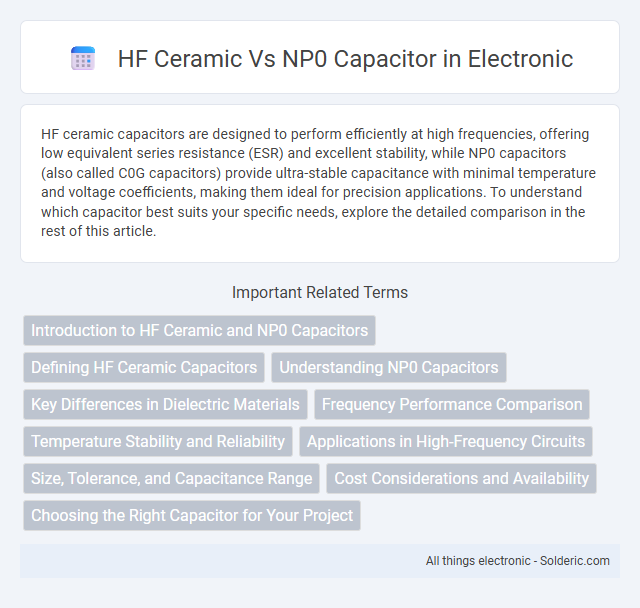HF ceramic capacitors are designed to perform efficiently at high frequencies, offering low equivalent series resistance (ESR) and excellent stability, while NP0 capacitors (also called C0G capacitors) provide ultra-stable capacitance with minimal temperature and voltage coefficients, making them ideal for precision applications. To understand which capacitor best suits your specific needs, explore the detailed comparison in the rest of this article.
Comparison Table
| Feature | HF Ceramic Capacitor | NP0 Capacitor |
|---|---|---|
| Dielectric Material | High-Frequency Ceramic | Class 1 Ceramic (C0G/NP0) |
| Temperature Stability | Moderate (+-10% typical) | Excellent (+-30 ppm/degC) |
| Frequency Range | Up to GHz range | Up to GHz range |
| Dielectric Constant (k) | Medium to High (20-100) | Low (~30) |
| Dielectric Loss (Dissipation Factor) | Low to moderate (~0.001-0.005) | Very low (~0.0001) |
| Capacitance Range | pF to uF | pF to nF |
| Applications | RF circuits, impedance matching, filters | Precision timing, oscillators, filters |
| Price | Moderate | Higher (due to precision) |
Introduction to HF Ceramic and NP0 Capacitors
HF ceramic capacitors, specifically designed for high-frequency applications, offer low equivalent series resistance (ESR) and stable capacitance over a wide frequency range, making them ideal for RF circuits and signal filtering. NP0 capacitors, a subtype of ceramic capacitors classified under the C0G dielectric class, exhibit near-zero temperature coefficient and minimal capacitance change with voltage, ensuring exceptional stability in precision timing and resonant circuits. Both capacitors are essential in electronic designs requiring reliability and performance, yet HF ceramics prioritize frequency response while NP0 capacitors emphasize temperature and voltage stability.
Defining HF Ceramic Capacitors
HF ceramic capacitors are high-frequency components designed with specialized dielectric materials to minimize losses and maintain stable capacitance at GHz frequencies. These capacitors offer superior performance in RF circuits compared to NP0 capacitors, which provide excellent temperature stability but are optimized for lower frequency applications. Choosing the right capacitor impacts your circuit's efficiency and signal integrity in high-frequency domains.
Understanding NP0 Capacitors
NP0 capacitors are a type of ceramic capacitor with a stable dielectric material, providing consistent capacitance over temperature ranges from -55degC to 125degC. Unlike HF ceramics, which target high-frequency applications but may experience more capacitance variation, NP0 capacitors maintain low Loss Tangent and minimal temperature coefficient, ensuring precise performance in timing and filtering circuits. Your choice of NP0 capacitors guarantees reliable stability for sensitive electronic components requiring minimal distortion and predictable behavior.
Key Differences in Dielectric Materials
HF ceramic capacitors use high-frequency dielectric materials like X7R or C0G for stability in radio frequency applications, offering moderate permittivity and low loss. NP0 capacitors feature a pure ceramic dielectric with a Class 1 temperature coefficient, providing near-zero capacitance change over temperature and excellent stability. Your choice hinges on whether you need high-frequency performance or ultra-stable capacitance in precision circuits.
Frequency Performance Comparison
HF ceramic capacitors excel in high-frequency applications due to their low equivalent series resistance (ESR) and stable capacitance at frequencies above 1 MHz, making them ideal for RF circuits and high-speed signal processing. NP0 capacitors offer exceptional frequency stability with minimal capacitance variation across a wide temperature range, maintaining performance up to several MHz but typically exhibit higher ESR compared to HF ceramics. When selecting for frequency performance, HF ceramic capacitors provide superior low-loss characteristics at ultra-high frequencies, whereas NP0 capacitors ensure consistent dielectric response and reliability in precision timing circuits.
Temperature Stability and Reliability
HF ceramic capacitors offer excellent high-frequency performance but typically exhibit less temperature stability compared to NP0 capacitors, which maintain stable capacitance within +-30 ppm/degC over a wide temperature range. NP0 capacitors are highly reliable for precision applications due to their minimal dielectric absorption and low loss characteristics, ensuring consistent performance under thermal stress. Choosing NP0 capacitors enhances Your circuit's temperature stability and long-term reliability, especially in environments with fluctuating temperatures.
Applications in High-Frequency Circuits
HF ceramic capacitors are preferred in high-frequency circuits due to their low equivalent series resistance (ESR) and stable capacitance over a wide frequency range, making them ideal for RF signal filtering, tuning, and impedance matching. NP0 (C0G) capacitors offer excellent temperature stability and minimal dielectric loss, which ensures consistent performance in precision oscillator circuits and high-frequency resonators. Your high-frequency design benefits from selecting HF ceramic or NP0 capacitors based on the specific trade-offs between stability, dielectric loss, and frequency response.
Size, Tolerance, and Capacitance Range
HF ceramic capacitors typically offer smaller sizes compared to NP0 capacitors, making them ideal for compact circuit designs. The tolerance of NP0 capacitors is usually tighter, around +-5%, ensuring greater precision in applications requiring stable capacitance values. Your choice depends on the required capacitance range, with HF ceramics available in a broader range but NP0 capacitors excelling in stability for low-capacitance values.
Cost Considerations and Availability
HF ceramic capacitors typically offer lower cost and broader availability due to their widespread use in high-frequency applications and simpler manufacturing processes. NP0 capacitors, known for their superior temperature stability and low loss, tend to be more expensive and less readily available, especially in specialized or high-precision grades. The choice between HF ceramic and NP0 capacitors often balances budget constraints against performance requirements, with cost-sensitive projects favoring HF ceramics and stability-critical designs opting for NP0 types.
Choosing the Right Capacitor for Your Project
HF ceramic capacitors offer high-frequency performance and low equivalent series resistance (ESR), making them ideal for RF and high-speed digital circuits. NP0 capacitors, known for their temperature stability and low dielectric absorption, are perfect for precision timing and filtering applications. Selecting the right capacitor depends on your project's frequency range, stability needs, and tolerance for signal integrity.
HF ceramic vs NP0 capacitor Infographic

 solderic.com
solderic.com